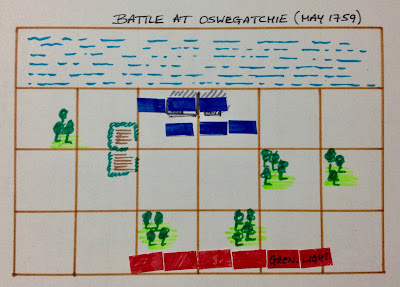Well, the French Indian War campaign has come to a close. I thought there might be one or two more battles to play out, but at the operational level fate was on the side of the British and not the French. The final events are detailed on Jonathan’s Palouse Wargaming Journal.
Finishing this campaign is like when you have read the last page of a really good book. A slight sense of loss prevails you and you wonder what will take its place.
This campaign was run as a "solo campaign relay" and started way back in February this year. When Jonathan put forward the idea which consisted of him running the operational aspects of a FIW campaign while I fought out the battles on the wargame table. The original concept is detailed here.
The campaign lasted for just over 5 months and involved playing out some 20 battles. These battles involved: 14 attacks of forts, 5 battles without a fort, and 1 major siege. While the French lost the campaign, they actually won more battles (11 of the 20 engagements).
So some thoughts on the campaign...
Why did it work and last for 5+ months and not fizzle out?
The battles were played using a heavily modified variant of one-hour wargames. This meant all games were play to a conclusion normally within 1 hour and I could fit a game in easily in an evening. More often than not, I would set up one evening and play the next.
Most games were played with between 6 and 10 units of plastic Spencer-Smith Seven Years War figures. They are simply painted, and its is always a joy to pull them out of their containers and place them on the tabletop ready for a game.
 |
| A game in progress |
Did I get the context to the battles?
Yes, the context came in two areas. Firstly, Jonathan provided an excellent campaign narrative and suggestions with each battle. Secondly, before most battles I took the opportunity to read up about the locations history and view map images of the period to help get a feel for how to setup the tabletop.
 |
| An attack on a fort - a necessary photo after 14 games involving forts. |
Did the rules work out?
The rules are pretty well settled after 20 games. The combination of campaign rules and tabletop rules helped improve how regulars, militia, and warbands were defined in term of hits accumulated before elimination and combat values.
Commander quality also made its way into the rules. Whereby a commanders defensive or attacking qualities improve his units resilience (hits they could take) depending if they were attacking or defending in the battle.
I now need to post the final rules and make a booklet as I have with by WW2 and Napoleonic rules.
Highlights of the campaign?
Some of the earlier games with the contest of Fort William-Henry were very interesting. Possible the taking of forts become a tad less interesting as the campaign progressed. However, the siege of Quebec (game 15) was most enjoyable and allowed me to get my star-fort onto the tabletop.
 |
| The Siege of Quebec |










































